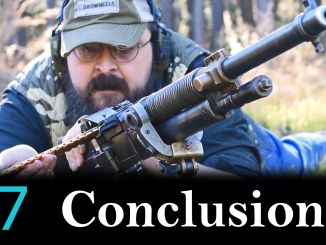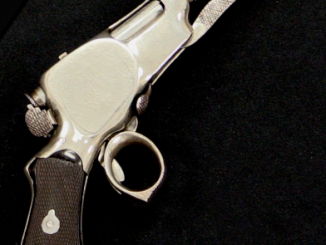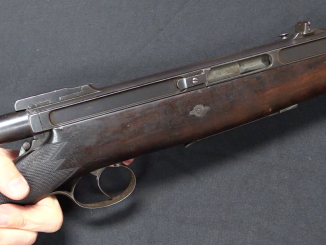This transferrable Schwarzlose HMG is being sold at Morphys on October 30, 2018.
The Schwarzlose 07/12 was made through the wolf of World War One as the standard heavy machine gun of the Austro-Hungarian armed forces, and many of them remained after the war ended. With the breakup of the Austro-hungarian Empire, these guns were dispersed to a variety of nations, among them Romania. The Romanians contracted with FN between the world wars for new 8x57mm barrels and converted a substantial number of Schwarzlose machine guns to 8×57 to match the other arms in use by the Romanian military. These guns appear to have seen little (if any) use in World War Two, and were brought into the US a few decades ago. Being after 1968, they could not be imported as live machine gun, and were instead cut into parts kits. The parts, however, are an easy drop-in conversion on an original 8x50mm Schwarzlose, resulting in a far more easily shootable machine gun thanks to the availability of 8x57mm ammunition.
In addition to the caliber conversion, several other changes were made to the guns. The water jacket and barrel were lengthened by about 4 inches and the cartridge oiler was disabled. The rear sight was replaced with one calibrated for both light and heavy 8mm Mauser loadings, and a set of mounting brackets were added to the top cover – probably for anti-aircraft sights.




Maybe a tv series? “The Wolf of WW1”.
Hmm… “wolf of World War One”?
I know one ship which fit: https://en.wikipedia.org/wiki/HMS_Wolf_(1897)
There were similar Yugoslav and Czech conversions also.
“Czech”
Official designation for Czech-converted gun: Těžký kulomet vz. 7/24, photos: https://www.ropiky.net/clanky_item.php?id=1093986205
These guns also have longer barrels.
This article (in Slovak or Czech language): https://www.vojsko.net/index.php/ceskoslovensko/3175-zbrane-pro-pechotu-prvni-republiky-9-dil-tezky-kulomet-podpurna-zbran-pechoty-vyssi-urovne
if I understand correctly, says that there existed Těžký kulomet vzor 7/24 and Těžký kulomet vzor 24, but I am unable to gather was what difference between them.
Anyway it states Rate-of-Fire of Těžký kulomet československé výroby vzor 24 (most probably alternative designation to Těžký kulomet vzor 24) as equal to 520 rpm. I do not know if this is effect of cartridge change alone or other modifications were done to speed it up (in comparison to original).
Thanks for bringing up existence and modification to this (almost) phenomenal weapon in Czech-Slovak service between wars.
From what I am reading in first referenced article, the designation vz.7/24 is used for modified original 8x50mm Mod.7/12 Schwarzlose in Czech service, used primarily in border fortifications. It should not be confused with more common vz.24 light machinegun for same caliber.
Btw. in mentioned reference, in first paragraph, they talk about shortcomings of this model. They were allegedly causing stoppages with textile belt. I wonder what was Romanian experience in this combination.
This article [Russian language] http://www.historymania.info/view_post.php?id=168 had interesting data regarding history of Schwarzlose machine gun, chapter Дальнейшая карьера «Шварцлозе» deals with time after Great War.
After fall of Austria-Hungary Schwarzlose machine guns naturally goes to inventory of countries which appeared. Namely Hungary, Czechoslovakia and Poland. Bulgaria used them both in original and lightened “hand-held” form [I presume it was like MG 08/15 to MG 08, but will be content with any additional data]. Bulgarians also mated some MG 08 machine guns to Schwarzlose’s tripods. Finland also used Schwarzlose machine guns captured from Russian forces. As trophy Schwarzlose machine guns even reached Australia.
In Czechoslovakia engineer František Janeček (he is known as founder of JAWA motorcycles) designed modernization of Schwarzlose machine gun with longer barrel and water jacket and make it “convertible” between Austrian 8×50 R cartridge and Mauser 7,9×57 (i.e. you can switch between them by replacing elements). After 1924 trials it was adopted – solely 7,9 mm version. Updated [already existing] machine guns become M1907/24 [vz. 7/24], while new production [build from scratch] machine guns become M1924 [vz. 24].
František Holek [brother of Václav Holek] and Rudolf Jelen created own variants of more deep modernization [how deep?] of Schwarzlose machine gun, but these were not processed further, as reworked Schwarzlose machine gun were considered as stop-gap solution until domestic machine gun would be adopted [this raise question why they build new ones then?]. Until 1928 Janeček modernized ~5000 machine guns, after that new M1924 were produced until 1932. These machine gun were not only used by Czechoslovak forces, but also few hundreds were sold abroad to: Brasilia, Columbia, China, Sweden. In Czechoslovakia it was used as infantry machine gun, fortress machine gun and armament of following AFVs: [Škoda] PA-II [“Želva”] armoured car, [Škoda] PA-III armoured car, MU-2 tiny tank prototype [cf. photos: http://peashooter85.tumblr.com/post/169486452578/the-skoda-mu-2-designed-by-the-czechoslovakian ]
In Hungarian and Italian forces Schwarzlose machine gun served until 1945. In Hungary it was reworked for 8×56 R cartridge with Spitzer bullet and thus become M 7/31. In Sweden it was license produced by Carl Gustaf factory. In Austria it was also reworked for 8×56 R cartridge with Spitzer bullet and gets new flash hider, it was also used as armament for AFVs for example ADGZ armoured car. Small number of Schwarzlose machine guns was used by Germany yet during Great War. After Anschluss of Austria and occupation of Czechoslovakia, Schwarzlose machine guns although dated were still in usage by Germans out of lack of newer machine guns in enough number. As for 1 September 1939 Germans have 175176 machine guns including MG.08 and MG.08/15 and MG.13 – 42722 examples, Czech ZB-26 – 31204 examples, Czech ZB-37 and Austrian 07/12 Schwarzlose, 07/24 Schwarzlose and MG30 – 17172 examples. During Second World War it was used by Wehrmacht in secondary roles, for example aerodromes protection. It is known that Luftwaffe used Universal Carrier-mounted Schwarzlose machine gun. Schwarzlose machine guns was also used to equip “foreign” (quisling) forces, including Ataman Pavlov’s cossacks. [S.V.Pavlov, see 1st photo from top, 1st man from left – https://aquilaaquilonis.livejournal.com/430566.html ]
In limited number it was also used after World War II, namely by Haganah during Arab-Israeli War (1948-1949). In 1960s Schwarzlose machine guns were used in Mozambique against Portuguese forces.
Also, it looks that Schwarzlose inspired Bulgarian self-taught designer Spasov to create own machine gun, though it was short-recoil operated.
See photos:
Initial water-cooled variant: https://strangernn.livejournal.com/1749330.html
Later light variant, magazine fed, photo and patent drawing: https://raigap.livejournal.com/517114.html
These never go past prototype stage.
“Schwarzlose HMG Converted”
Schwarzlose machine gun was quite flexible in cartridge choice, at least regarding new production (rather than conversion), Holland used this machine gun chambered for Schaarpe Patroon 23: http://municion.org/8x57jrs/Dutch.htm
Although designated 7.92x57R it is NOT 7.92×57 JRS as used in German hunting rifles. Due to similar dimension it is sometimes confused with ·303 British when old case is picked from old battlefield in deteriorated state.
Kulspruta m/1914 is Schwarzlose chambered for 6.5×55 cartridge.
According to http://www.airwar.ru/weapon/guns/schwarzlose.html considerable number of Austrian Schwarzlose machine gun were captured by Russian forces during Great War. Some of them were converted to 7,62×54 R but also production of 8×50 R cartridge was started, nonetheless there was still lack of ammunition. In mid 1916 Russian High Command considered normal monthly consumption to be 225 000 000 rifle cartridge, including 25 000 000 Austrian. Petrograd (this city is now known as Petersburg) ammunition plant monthly output of Austrian rifle cartridge was in October-November 1916 equal to 13 500 000 Austrian rifle cartridges.
K.u.K. Luftfahrtruppen used Schwarzlose as aviation machine gun. Initially with perforated water jacket (similarly to German machine guns) and with Rate-of-Fire increased to 600 rpm. Later jacket was totally abandoned and such gun was named M07/12/R16 alias MG.16. Near end of war MG.16A variant appeared, which again has increased Rate-of-Fire, now to 880 rpm.
As side notice: see 2nd image in gallery to see how big receiver of this machine gun is in relation to barrel (without water jacket)
I suspect that Russian command soon found that original 8mm Schwarzlose MG was not well suited for 7.62x54R round, just like was the case with 8mm Mauser as Czechs found themselves too. Other than that, with the original 8x50mmR ammo it surely was first class war booty.
Here is a re-enactment video conducted in Czech republic with variety of vintage machineguns among them also vz.07/24.
https://www.youtube.com/watch?v=O0pSFzoLAjY
The gun(s) works ‘well’ during the display, mainly due to shooting tailored blanks.
Someone in discussion laments absence of subtitles in English. Well, here multilinguals like Daweo (I cannot claim that title since I am not fluent in Russian and Polish) have clear advantage 🙂
Camp mabry in Austin was trying to get theirs running with blanks for an event but was unsuccessful I would have loved to see it shoot.
Another video detailed and made with great professionalism; but I have a doubt. It seems to me that the reduced length of the barrel of the Schwarzlose is due precisely to the closing system adopted: in this way, when the effective bolt’s opening begins, the projectile has already left the barrel. This provoked, among other things, a very visible muzzle flash, for which the characteristic and “disproportionate” conical flash hider was adopted. In the same way, the lubrication of the cartridges was necessary to prevent their adhesion to the combustion chamber during the primary phase of the extraction (fluted chambers did not exist yet).
So my question is this: how can this conversion work well with the inhibited lubrication, a longer barrel and using a more powerful ammunition than the original?
W.H.B. Smith states that the short barrel was needed to ensure that the bullet had in fact left the muzzle before the breechblock began to open, to ensure a safely low breech pressure during the extraction/ejection phase of the operating cycle.
The SAAMI maximum allowable pressure for the 7.9 x 57mm Mauser is 35,000 PSI. The 8 x 50Rmm operated at a substantially lower pressure. Running a Schwarzloze in 7.9 x 57mm even with the older, lower-pressure “Pre-S” loads would be questionable with a barrel the same length as the original 8 x 50Rmm barrel. Doing so with the Pre-S load in a longer barrel would be asking for trouble, as the pressure peak dwell would of course be of longer duration.
Putting S bullet loads intended for post-1918 7.9 x 57mm weapons into such a modified MG would, in my opinion, be risking an explosion in the breech. At the very least I’d expect frequent split cases and case-head separations, much as the French experienced with the AAT-52 GPMG in 7.5 x 554 and later in 7.62 x 51.
It just goes to show that wartime expedients don’t always look like such a good- or safe- idea after the armistice has been signed.
cheers
eon
Here: http://rusplt.ru/ww1/history/v-pritsele-dvuedinoy-monarhii-14781.html
you can see Schwarzlose himself firing own machine gun. It also states that Austria-Hungary tested Schwarzlose design against Maxim, muzzle velocity were respectively 610 m/s and 865 m/s, but first have 166 details compared to at least [Russian, simplest variant] 282 details of latter. First was also lighter at 41 kg compared to 64 kg.
This is an excellent article Daweo; the time period pictures are great. It brings me back to time of my visit to the area at occasion of 100th anniversary of break of hostilities between Italy and A-H monarchy.
Mr. Schwarzlose is a slick looking fella. I’d love to have a chat with him, if time shift was possible.
Actually conversions worked fine, only problem being noted in Yugoslav service were cloth belts.
Still, M.07/24S Schwartzlose and M.08M Maxim were both considered superior to a rebarreled Hotchkiss M.14/26H. So Hotchkiss went to a reserve in 1936-37 and SL and Maxim stayed in use (together with newly acquired M.40ZB/ZB-53 until the German invasion.
http://hungariae.com/Schwarz.htm states that in Hungary some Schwarzlose machine guns were converted to 8x56mm 31.M ‘Hegyes’ cartridge (rimmed with Spitzer bullet). Early conversion offered 700 m/s muzzle velocity compared to 580 m/s of original, but some reliability issues were found, so new conversion method was developed, which improved reliability and additionally offered 730 m/s muzzle velocity. Accordingly sights were replaced with new metric ones. Interestingly The gun was fed by a canvas belt, during WW2 metal belts were also used., which suggest similar problems to version described by bojan and means Hungarians still used Schwarzlose machine guns during WW2, in quantity justifying introduction of new belts.
Keep in mind range was increased not only by muzzle velocity boost but also using Spitzer rather than round nose bullet.
“SAAMI maximum allowable pressure for the 7.9 x 57mm Mauser is 35,000 PSI”
According to my data Czechoslovak 7,9×57 cartridge have powder charge between 2.7 g (cartridge with tracer bullet) to 3.0 g (cartridge with AP bullet), while most standard “cartridge with heavy bullet” have powder charge 2.9 g.
For comparison “Austrian 8 mm rifle cartridge with round nose bullet” has 2.65 g powder charge.
Powder charge weight means little without knowing the actual powder used.
“Powder charge weight means little without knowing the actual powder used.”
Альбом конструкций патронов стрелкового оружия states pressure 2750 kg/cm^2 for one of 7,9 mm Czechoslovak cartridge (one with 2,77 g powder charge).
For comparison:
7,62×54 R with light bullet – 3050 kg/cm^2
7,9×57, German, S bullet – 2850 kg/cm^2
7,9×57, German, SS bullet – 3000 kg/cm^2
7,9×57, German, SmK bullet – 3250 kg/cm^2
7,9×57, German, SmK(H) bullet – 3710 kg/cm^2
7,7 mm (·303) British, Mk VII bullet – 3020 kg/cm^2
8 mm, French, D bullet – 2750 kg/cm^2
This is one of those instances where Smith is clearly wrong. Like Bojan already wrote, the conversions worked quite well. Smith appears to be getting his information from Chinn, or an earlier source used also by Chinn in any case. Chinn had the mistaken opinion that adding significantly more mechanical disadvantage to the retarding mechanisms to accommodate longer barrels would not be possible: “If any longer barrel were to be used, with the rifle caliber cartridge it was designed for, the mechanism, to be safe, would assume such large proportions that it could not remain in the portable machine gun class.”
This was clearly not correct, since conversion to a longer barrel and/or more higher velocity and higher pressure cartridge was carried out in multiple countries successfully.
Fact that in Czechoslovakia over 5000 examples of 7.9 mm Schwarzlose were created (both from older machine guns and brand new ones), lead to following conclusion: either 7.9 mm Schwarzlose worked as intended
either Janeček was one of greatest conman in history of fire-arms/20th century selling not working product for several years.
Interesting observation: do you therefore believe that in these conversions the bolt (or only the oscillating part of it) has been suitably weighted? What is your opinion about the lack of lubrication? I do not think Schwarzlose has inserted this element for no reason …
*weighted down
The 07/12 could already run without lubricated cartridges thanks to heavier bolt and increased mechanical disadvantage in the toggle retarding mechanism, which slowed the bolt’s rearward movement down sufficiently.
A delayed blowback heavy machine gun. I’d love to see the insides. Especially the monstrous recoil spring.
http://tubidy.pw/watch/schwarzlose-machine-gun-1912/Fwhr4je3Smk
(I can’t vouch for its accuracy, but someone has an animation, including the oil spray)
Schwarzlose cut-away drawing: http://ww1.milua.org/svarzmanunal.htm
Also I found drawing of lightened variant: http://ww1.milua.org/shvarzloze07-ruch.htm
100 rounds belts were used and triggering mechanism unchanged, so it was clearly more-or-less improvised solution, inferior to fully hand-held machine guns, but more portable than original Schwarzlose (with tripod).
Good stuff, Daweo.
Just occurred to me (and wondering why so late), this toggle linkage is very similar in conception to toggle-breech delayed Schwarzlose’s pistol Ian’s once presented. As I remember, it did not have much practical commercial success.
Good presentation. That breech mechanism is simply ingenious.
Interesting reading! The Steyr 07/12s converted to 7.92 imported and sold as kits by IMA in the US were originally in 8x50r. A unique feature of the Schwarzlose is that the feedlips are milled into the bottom of the receiver and are caliber specific. The configuration of the milled feedlips for the 8x50r are very different than the feedlips that would be milled for feeding 7.92×57. The 07/12s that were imported into the US as “converted to 7.92” still had receiver feedlips milled to feed 8x50r and the mouth of the belt feed under the receiver had not been slightly lengthened to feed the longer 7.92 cartridge. So, these guns could not possibly have fired 7.92 rounds since they’re were still configured to fire 8x50r!
I did the torch cutting of the receivers into kits of these 07/12s at Century Arms and spent quite a few hours working on them and organizing the cut parts so became very familiar with their condition. I also converted a live, registered 07/12 Stey receiver to fire the 7.92 round using one of the kits I torched. I had to reconfigure the feedlips to feed the 7.92 cartridge and lengthen the mouth of the belt feed below the receiver.
While the 7.92 internals will fit perfectly into the 8x50r receivers, without the modification of the feedlip, it will not function with 7.92. The 7.92 internals with those guns were from CZ M24s. The longer barrels were made by FN and many were converted using 8x50r breech sections and sleeved with 7.92 barrels.
Hope this clears up the misinformation about the 7.92 kit parts being “drop in” conversions into 8x50r 07/12 receivers. Bob NAESS, Black River Militaria CII